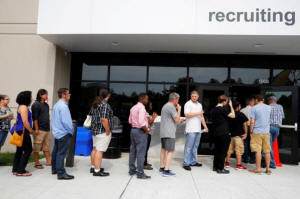U.S. hiring accelerates; annual wage growth strongest
since 2009
 Send a link to a friend
Send a link to a friend
 [February 03, 2018]
By Lucia Mutikani [February 03, 2018]
By Lucia Mutikani
WASHINGTON (Reuters) - U.S. job growth
surged in January and wages increased further, recording their largest
annual gain in more than 8-1/2 years, bolstering expectations that
inflation will push higher this year as the labor market hits full
employment.
Nonfarm payrolls jumped by 200,000 jobs last month after rising 160,000
in December, the Labor Department said on Friday.
The unemployment rate was unchanged at a 17-year low of 4.1 percent.
Average hourly earnings rose 0.3 percent in January to $26.74, building
on December's solid 0.4 percent gain.
That boosted the year-on-year increase in average hourly earnings to 2.9
percent, the largest rise since June 2009, from 2.7 percent in December.
Workers, however, put in fewer hours last month likely because of
bitterly cold weather.
The average workweek fell to 34.3 hours, the shortest in four months,
from 34.5 hours in December.
The robust employment report underscored the strong momentum in the
economy, raising the possibility that the Federal Reserve could be a bit
more aggressive in raising interest rates this year. The U.S. central
bank has forecast three rate increases this year after raising borrowing
costs three times in 2017.
"The acceleration in average hourly earnings growth punches a hole in
the narrative that wage growth remains lackluster," said Scott Anderson,
chief economist at Bank of the West in San Francisco. "The Goldilocks
view of inflation is being sorely challenged right now."

Fed officials on Wednesday expressed optimism that inflation will rise
toward the central bank's target this year. Policymakers, who voted to
keep interest rates unchanged, described the labor market as having
"continued to strengthen," and economic activity as "rising at a solid
rate."
U.S. financial markets have priced in a rate hike in March. Prices for
U.S. Treasuries fell, with the yield on the benchmark 10-year note
hitting a four-year high as investors worried about high inflation. The
dollar rose against a basket of currencies on the data while U.S. stocks
were trading lower.
The unemployment rate dropped seven-tenths of a percentage point in 2017
and economists expect it to hit 3.5 percent by the end of the year.
Economists say job gains are being driven by buoyant domestic and global
demand.
Some worry that the Trump administration's $1.5 billion tax cut package
passed by the Republican-controlled U.S. Congress in December, in the
biggest overhaul of the tax code in 30 years, could cause the economy,
already operating near full capacity, to overheat.
President Donald Trump and his fellow Republicans have cast the fiscal
stimulus, which includes a reduction in the corporate income tax rate to
21 percent from 35 percent, as creating jobs and boosting economic
growth.
"If the labor market is this strong and the tax cuts have yet to kick
in, what will it look like when households and businesses actually start
spending the money?" said Joel Naroff, chief economist at Naroff
Economic Advisors in Holland Pennsylvania. "No good economy goes
unpunished and the punishment may already be starting to be meted out."

[to top of second column] |

Job seekers line up to apply during "Amazon Jobs Day," a job fair
being held at 10 fulfillment centers across the United States aimed
at filling more than 50,000 jobs, at the Amazon.com Fulfillment
Center in Fall River, Massachusetts, U.S., August 2, 2017.
REUTERS/Brian Snyder/File Photo

JOB GROWTH SEEN SLOWING
Economists polled by Reuters had forecast nonfarm payrolls rising by 180,000
jobs last month and the unemployment rate unchanged at 4.1 percent. January's
jobs gains were above the monthly average of 192,000 over the past three months.
The economy needs to create 75,000 to 100,000 jobs per month to keep up with
growth in the working-age population.
January marked the first full year of employment data under the Trump
administration. Job growth averaged 176,000 per month under the current
government, compared to 208,300 during last year of the Obama administration.
Job growth is expected to slow this year as the labor market hits full
employment. Companies are already reporting difficulties finding qualified
workers, which economists say will force some to significantly raise wages as
they compete for scarce labor.
Wage growth last month came as increases in the minimum wage came into effect in
18 states in January. Wages probably also got a lift from the tax cut. Companies
like Starbucks Corp and FedEx Corp have said they will use some of the savings
from lower taxes to boost wages for workers.
Further gains are expected in February when Walmart raises entry-level wages for
hourly employees at its U.S. stores. Annual wage growth is now close to the 3
percent that economists say is needed to push inflation towards the Fed's 2
percent target.
But the road to faster wage growth remains long. The year-on-year rise in
average hourly earnings for production and non-supervisory workers was stuck at
2.4 percent in January.
A broader measure of unemployment, which includes people who want to work but
have given up searching and those working part time because they cannot find
full-time employment, rose one-tenth of a percentage point to 8.2 percent in
January.
The unemployment rate for African Americans shot up to 7.7 percent from 6.8
percent and is more than double that of whites.

Manufacturing payrolls increased by 15,000 last month after rising 21,000 in
December. The sector is being supported by strong domestic and international
demand. A weak dollar is also providing a boost to manufacturing by making
U.S.-made goods more competitive on the international market.
Hiring at construction sites picked up last month despite unseasonably cold
weather. Construction payrolls increased by 36,000 jobs, adding to December's
33,000 gain.
Retail employment rebounded and the government added jobs following two straight
months of declines.
There were also increases in payrolls for professional and business services,
leisure and hospitality as well as healthcare and social assistance.
(Reporting by Lucia Mutikani; Editing by Andrea Ricci)
[© 2018 Thomson Reuters. All rights
reserved.] Copyright 2018 Reuters. All rights reserved. This material may not be published,
broadcast, rewritten or redistributed.
Thompson Reuters is solely responsible for this content. |